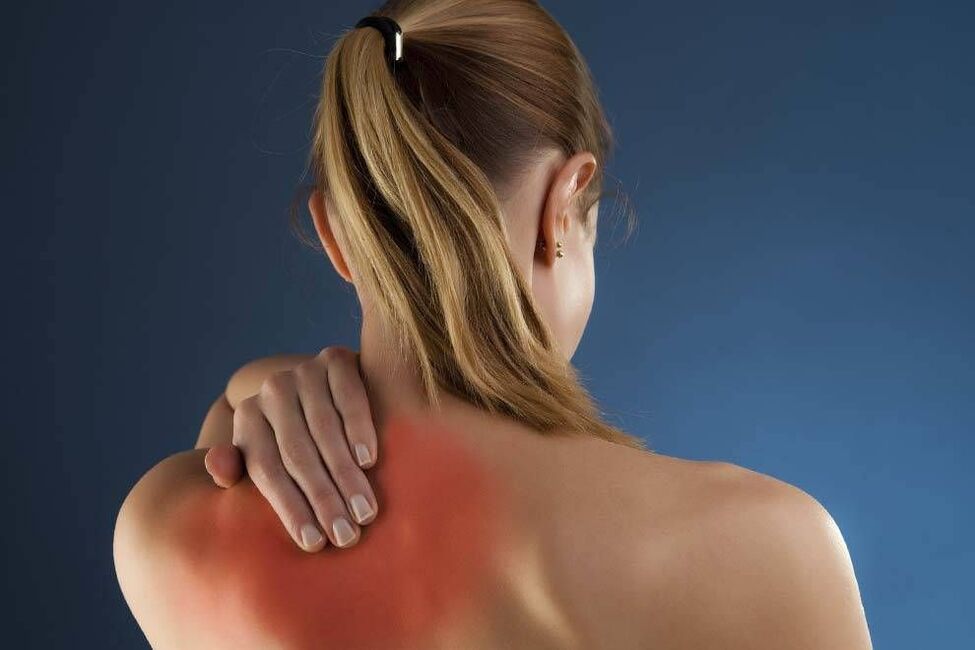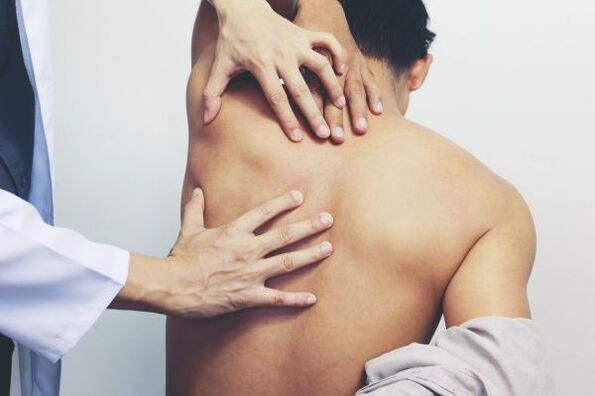
Pain under the left shoulder bladeobserved in musculoskeletal pathology (osteochondrosis, myofascial syndrome, injury), heart disease (myocardial infarction, angina pectoris, rheumatic and non-rheumatic carditis), gastrointestinal disease (pancreatitis, stomach ulcer). Rarer causes of symptoms include damage to the spleen, ulcers and skin tumors. Diagnostic methods are chosen based on the underlying syndrome: X-ray, ultrasound and endoscopic examination are used. To relieve pain, analgesics are prescribed, after which medical or surgical treatment of the underlying disease is carried out.
Causes of pain under the left shoulder blade
Radicular syndrome
The pathological condition develops with thoracic osteochondrosis or intervertebral hernia. Less commonly, radicular pain occurs with spondylolisthesis and ankylosing spondylitis. Acute pain in the projection of the left scapula is observed when the 3-6th thoracic root is involved in the process; discomfort directly under the scapula indicates localization of damage to the 7-8th vertebra. Usually, the pain spreads from the scapula to the lateral surface of the chest and intercostal space.
Myofascial pain syndrome
Poor posture and long stays in uncomfortable positions lead to constant muscle tension. This syndrome manifests itself as pain in the scapula area on the left side, when the load is mostly on this side. Discomfort is perceived by the patient as deep and moderately intense. At first, the pain is only experienced during movement and exercise, but over time it becomes constant. Sometimes a radiating pain appears in the forearm or left hand.
injury
Severe pain develops after a crack or fracture of the scapula or soft tissue bruising in this area. If the integrity of the bone is preserved, the pain is moderate, the person can take a deep breath and move freely. When traumatic damage to the bone structure occurs, sharp pain occurs, and the mobility of the arm and shoulder girdle is often limited. When changing position or pressing on the injured area, a sharp pain is felt.

Boils and carbuncles
Purulent inflammation of the skin surrounding the left shoulder blade is accompanied by severe pain, which, as a rule, is clearly localized. When the boil matures, a "pulling" sensation occurs, which intensifies when the inflamed area is touched or rubbed with clothing. After the tire bursts and the necrotic core comes out, the pain subsides. With a carbuncle, the pain is stronger, and the patient's general condition often worsens.
Heart disease
Damage to the heart is a common cause of pain under the left scapula, which is associated with the proximity of the anatomical location and conservation features. In this case, the symptoms are accompanied by pain in the chest of various types, feeling frozen or disturbances in the heart's function. Tachycardia and other rhythm disturbances are usually detected. Pain under the shoulder blade manifests itself as:
- Myocardial infarction.The patient experiences an unbearable burning sensation that spreads from the precordial region to the left arm and shoulder blade, and less often to the clavicle and neck region. This condition occurs suddenly and is accompanied by a strong fear of death and fainting.
- Stable angina.Episodes of squeezing or pressing pain radiating to the subscapular region are specific to ischemic heart disease attacks. Unpleasant symptoms are provoked by physical activity or emotional stress and last on average up to 10-15 minutes. After resting or taking nitrates, the pain disappears.
- Inflammatory heart disease.A dull or stabbing pain in the chest, which radiates to the left shoulder blade and bothers the patient for several days, is typical for acute carditis (myocarditis, pericarditis). The person also complains of shortness of breath, increased body temperature, and swelling of the lower legs.
- Joint pain.Radiating pain in the left side of the back in combination with cardialgia is characteristic of the clinical picture of rheumatic carditis. The clinical picture is accompanied by arthralgia, ring-shaped erythema of the skin, and rheumatic nodules. Symptoms are more often detected in children and adolescents.
Pancreatitis
Girdle pain moving from the left hypochondrium to the subscapular region is observed with acute pancreatitis. In addition to the pain syndrome, patients are concerned about debilitating vomiting with bile and mucus impurities, and tension in the abdominal muscles. Movement increases the painful sensation, so the person tries to lie on his side without moving.
In chronic pancreatitis, radiating pain under the scapula indicates an exacerbation of the process. Most often, violations are provoked by mistakes in the diet - big parties, drinking alcohol. The pain is paroxysmal in nature, sometimes spreading not only to the subscapularis, but also to the precordial region. Symptoms are combined with nausea, flatulence, and steatorrhea.
Stomach ulcer
Pain under the left shoulder blade is a sign of localization of the defect on the back wall of the abdomen, closer to the back. Unpleasant sensations appear within 20-50 minutes after eating. The earlier symptoms occur, the higher the location of the ulcer. The discomfort worsens when eating sour, spicy or fried foods. To reduce the intensity of the pain, the patient induces vomiting.
Spleen disease
Pain and fullness in the left subscapular region occurs with splenomegaly caused by an infectious, autoimmune or myeloproliferative process. With the gradual enlargement of the organ, periodic discomfort develops with heaviness in the affected area, and the rapid change in the size of the spleen is accompanied by a sharp cutting pain radiating under the left shoulder blade.
Less often, the cause of pain is surgical pathology of the spleen: rupture, infarction, volvulus. In this case, there is a cutting or throbbing pain that radiates below the scapula, which is aggravated by the slightest movement. Therefore, the patient takes a forced position: lying on his left side or on his back with his knees resting on his stomach. The clinical picture is accompanied by a sudden drop in blood pressure and tachycardia. If there is insufficient pain relief, shock occurs.
Bronchopulmonary pathology
Left-sided focal processes in the lungs often cause pain in the projection of the scapula. Discomfort increases with deep breathing, laughing and talking, and coughing fits. Pain has different characteristics: sharp, stabbing, dull, pressing. They are accompanied by fever, shortness of breath and other common respiratory symptoms. Most often, pain under the left shoulder blade is experienced by patients who have:
- Pneumonia.The patient feels a moderate dull pain, which has a clear localization in the case of focal inflammation of the lungs or spreads to the entire scapular area in the case of lobar pneumonia. A deep cough appears with the release of mucopurulent sputum. Symptoms last up to 2-4 weeks.
- Pleurisy.With exudative pleurisy, a person experiences pressure and rupture under the scapula and along the side wall of the chest. When you feel this area, the discomfort increases. Dry pleurisy is characterized by acute pain in the chest and subscapular region, aggravated by movement.
- Dry cough.Tuberculosis infection lasts a long time, so low-intensity pain continues for several months. If the pain is localized in the scapular area, the pathological focus is more likely to be located in the posterior part of the lung.
- Pulmonary infarction.The death of the pulmonary parenchyma is indicated by severe pain radiating under the left shoulder blade, clinically resembling an angina attack. The patient's condition is complicated by hemoptysis or pulmonary hemorrhage, external respiratory dysfunction, and arrhythmia.
A rare cause
- Neoplasms: osteoma and osteosarcoma, bone cyst, malignant tumor of the skin above the scapula (basal cell carcinoma, melanoma).
- Rare cardiovascular pathology: cardiac syndrome X, descending aortic aneurysm.
- Acute surgical disease: retroperitoneal abscess, hemoperitoneum, strangulated diaphragmatic hernia.
Diagnostics
Patients with pain below the left shoulder blade are first referred to consult an orthopedic traumatologist. In the absence of a musculoskeletal system disorder, other specialists are involved in the diagnostic search: neurologists, cardiologists, surgeons, etc. To determine the cause of pain, various instrumental studies are prescribed, including:
- Radiography.X-ray of the scapula in the frontal and lateral projections allows one to exclude or confirm traumatic injuries. Radiographic imaging of the spine is indicated for suspected osteochondrosis, scoliosis, or spondylolisthesis. Plain radiography of the chest cavity allows one to suspect damage to the lungs or heart.
- Electrocardiogram.A standard 12-lead ECG is a screening method, based on the results of which the doctor makes an initial diagnosis and identifies a dangerous process (myocardial infarction, life-threatening arrhythmia). The diagnostic complex is equipped with classic or transesophageal echocardiography and cardiac electrophysiology.
- Abdominal ultrasound.A quick and non-invasive method is used to detect common conditions that cause pain in the left shoulder blade. Ultrasound examination showed signs of gastric ulcer, inflammatory infiltrate of the pancreas, and an enlarged spleen. To clarify the diagnosis of peptic ulcer, EGD is used.
- Additional Methods. To clarify the nature and severity of bone changes, CT or MRI of the spine is performed. If there is a possibility of bronchopulmonary disease, bronchoscopy with biopsy and pleural puncture is performed. If there is difficulty in diagnosing abdominal pathology, diagnostic laparoscopy is recommended.
Laboratory examination methods play a major role in making a diagnosis. Clinical blood tests show signs of inflammation or disorders of the hematopoietic process. Acute phase protein indicators and proteinograms are informative in case of cardiac damage or autoimmune processes. Specific myocardial markers were assessed for angina pectoris.
To diagnose gastrointestinal diseases, a coprogram is performed: the presence of pancreatitis is indicated by a high content of undigested food particles, an increase in the number of striated muscle fibers and starch grains. In the case of inflammatory processes of the lungs and pleura, bacteriological seeding of biomaterials is required, followed by tests for the sensitivity of isolated microorganisms to antibiotics.

Treatment
Help before diagnosis
Given the various causes of pain under the left shoulder blade, it is very difficult for doctors to give recommendations until the underlying pathology is identified. During the examination, it is advisable to reduce the load on the back muscles to eliminate fatigue and easy fatigue, which can cause persistent pain symptoms. If the sensation is unbearable, analgesics are used and the patient is immediately hospitalized.
Conservative therapy
The treatment plan is selected only after a complete diagnosis and determination of the etiological factors of pain under the left shoulder blade. If the patient experiences severe discomfort, anti-inflammatory drugs and muscle relaxants are recommended, which quickly relieve the painful sensation. For severe pain, therapeutic restrictions and administration of narcotic analgesics are effective. Taking into account the disease, the mode of physical activity is selected.
Drug therapy is prescribed by a specialist of the appropriate profile. For pain caused by heart damage, cardiologists prescribe antianginal and antiarrhythmic drugs, antiplatelet and anticoagulant agents, and antihypertensive drugs. Diseases of the bronchopulmonary system require the participation of a pulmonologist and the use of antibiotics, expectorants, and specific anti-tuberculosis drugs.
For gastrointestinal pathology, an appropriate diet is selected and therapy is supplemented with enzyme preparations, prokinetics, antacids and antisecretory drugs. In neurology, neurometabolic agents, B vitamins, and drugs that improve microcirculation and blood rheological properties are shown to eliminate radicular syndrome.
For posture disorders and other problems with the spine, non-drug methods are actively used: traction therapy, therapeutic massage, exercise therapy. Among the physiotherapeutic methods, balneotherapy (sulfide and radon baths), mud therapy, and reflexology are popular. It is possible to increase the effectiveness of drug treatment by electrophoresis of drugs directly to the affected area.
Surgery
Surgical methods are indicated when conservative treatment is ineffective or in life-threatening acute pathologies, when delays are dangerous to the patient's life and health. The second group of operations includes stent methods, angioplasty and bypass surgery for myocardial infarction, abdominal or thoracic surgeon assistance for injuries, purulent processes, and internal bleeding.
Planned surgical intervention is often prescribed in neurosurgery for severe radicular syndrome and intervertebral hernia. To eliminate the pain associated with the compression of nerve structures, microdiscectomy and laser vaporization of the disc is performed. In rare cases, stabilization operations on the spine are used (interbody fusion, use of the Halo device, transpedicular fixation).

















































